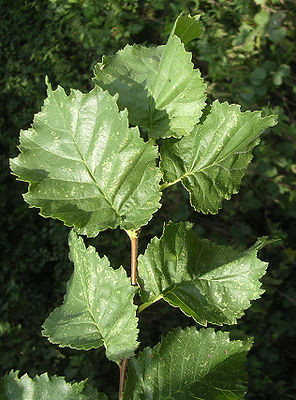English elm
| English elm | ||||||||||||
|---|---|---|---|---|---|---|---|---|---|---|---|---|

Ulmus procera |
||||||||||||
| Systematics | ||||||||||||
|
||||||||||||
| Scientific name | ||||||||||||
| Ulmus procera | ||||||||||||
| Salisb. |
The English elm ( Ulmus procera ), also called hair elm , is a species of the elm family (Ulmaceae).
description
The English elm is a deciduous tree about 20 meters wide, reaching heights of 1 to 40 meters and a thick trunk that is straight to the top of the tree . The bark is dark brown and furrowed. The oval, hairy leaves are up to 10 cm long.
The numerous, tiny elm blossoms grow in very small, red-brown, dold-like inflorescences close to the branches and appear as early as the end of February to April before the leaves. The inconspicuous, green flowers with a red border and brown stamens do not bloom equally strongly every year. After flowering, the small, winged fruits that are spread by the wind develop quickly.
Occurrence
The English elm is found in large parts of Europe and grows in forests and on hedges . This stately tree can live for a good five hundred years and needs 150 years to develop its full beauty. Nowadays it is difficult to find older hair elms, as the Dutch elm disease, which is more prevalent from time to time, has destroyed the majority (over 10 million trees have died from this disease in England).
Important ingredients
Tannins , phytosterol , mucilage , bitter substances , potassium , silicic acid
Web links
- photos
- English elms: clones for 2000 years.
- The English elm as a prime example of the structure of an elm.
- Elm species descriptions and data on elm wood
- International elm programs. ( Memento from January 6, 2013 in the web archive archive.today )
